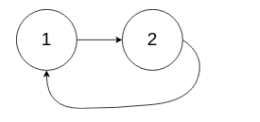给定一个链表,判断链表中是否有环。
为了表示给定链表中的环,我们使用整数 pos 来表示链表尾连接到链表中的位置(索引从 0 开始)。 如果 pos 是 -1,则在该链表中没有环。
示例 1:
输入:head = [3,2,0,-4], pos = 1
输出:true
解释:链表中有一个环,其尾部连接到第二个节点。
示例 2:
输入:head = [1,2], pos = 0
输出:true
解释:链表中有一个环,其尾部连接到第一个节点。
示例 3:
输入:head = [1], pos = -1
输出:false
解释:链表中没有环。
进阶:
你能用 O(1)(即,常量)内存解决此问题吗?
法一:快慢指针
时间复杂度:O(n),让我们将 nnn 设为链表中结点的总数。为了分析时间复杂度,我们分别考虑下面两种情况。
空间复杂度:O(1),我们只使用了慢指针和快指针两个结点,所以空间复杂度为 O(1)。
public class Solution {public boolean hasCycle(ListNode head) {if (head == null || head.next == null) return false;ListNode slow = head;ListNode fast = head.next;while (slow != fast) {if (fast == null || fast.next == null ) return false;slow = slow.next;fast = fast.next.next;}return true;}}

法二:哈希表
时间复杂度:O(n),对于含有 n 个元素的链表,我们访问每个元素最多一次。添加一个结点到哈希表中只需要花费 O(1) 的时间。
空间复杂度:O(n),空间取决于添加到哈希表中的元素数目,最多可以添加 n个元素。
public class Solution {public boolean hasCycle(ListNode head) {HashSet<ListNode> set = new HashSet<>();while (head != null) {if (set.contains(head)) return true;set.add(head);head = head.next;}return false;}}


